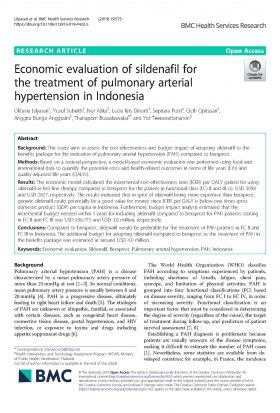This website uses cookies so that we can provide you with the best user experience possible. Cookie information is stored in your browser and performs functions such as recognising you when you return to our website and helping our team to understand which sections of the website you find most interesting and useful.
Economic Evaluation of Sildenafil for the Treatment of Pulmonary Arterial Hypertension in Indonesia

รายละเอียดเพิ่มเติม
Abstract
Background
This study aims to assess the cost-effectiveness and budget impact of adopting sildenafil to the benefits package for the indication of pulmonary arterial hypertension (PAH), compared to beraprost.
Methods
Based on a societal perspective, a model-based economic evaluation was performed using local and international data to quantify the potential costs and health-related outcomes in terms of life years (LYs) and quality-adjusted life years (QALYs).
Results
The economic model calculated the incremental cost-effectiveness ratio (ICER) per QALY gained for using sildenafil as first-line therapy compared to beraprost for the patient in functional class (FC) II and III, i.e. USD 3098 and USD 2827, respectively. The results indicated that in spite of sildenafil being more expensive than beraprost, generic sildenafil could potentially be a good value for money since ICER per QALY is below one times gross domestic product (GDP) per capita in Indonesia. Furthermore, budget impact analysis estimated that the incremental budget needed within 5 years for including sildenafil compared to beraprost for PAH patients starting in FC II and FC III was USD 436,775 and USD 3.6 million, respectively.
Conclusions
Compared to beraprost, sildenafil would be preferable for the treatment of PAH patients in FC II and FC III in Indonesia. The additional budget for adopting sildenafil compared to beraprost as the treatment of PAH in the benefits package was estimated at around USD 4.0 million.
Keywords
Economic evaluation Sildenafil Beraprost Pulmonary arterial hypertension PAH Indonesia




